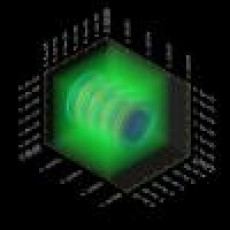Laser Wakefield Particle Acceleration
Key Challenges: Design of multiple-staged, 10-GeV laser-wakefield plasma accelerated next-generation hardware and experiments for the LBNL BELLA laser facility including controlled injection experiments to increase beam quality and stability. The plasma interaction in this regime is fully nonlinear, and there are huge differences in scale between the laser wavelength (sub-micron) and the plasma wakefield length (centimeters now, soon to be meters).
Why it Matters: Laser wakefield acceleration shows great promise for reducing the cost and size of next-generation electron and positron accelerators used as light-sources -- accelerators that generate X-rays for research in physics, material science, biology, chemistry, environmental science, and even archaeology. By creating a plasma wave via a laser pulse, accelerator gradients can been obtained that are thousands of times greater than those in conventional accelerators and the plasmas are not subject to the electrical breakdown that limits conventional accelerators.
Accomplishments: LBNL LOASIS staff and collaborators from Tech-X Corporation have successfully used VORPAL, a parallel framework for finite-difference time domain (FDTD) simulations of fields and particles of various types, on as many as 8,000 processors of the NERSC "Franklin" Cray XT4 system, to directly model 10 GeV (and beyond) accelerator stages, provide quantitative prediction of injector parameters to improve beam quality, and analyze physics of ongoing experiments.
Simulations confirmed the design of stages for the BELLA laser now under constructionfor and confirmed for the first time the predicted scaling of LPA performance to very high energies for efficient, deeply depleted and beam loaded stages.
NERSC Analytics Group staff provided algorithms and production-quality software infrastructure to perform interactive visual data analysis (identify, track, analyze beam particles) in multi-TB simulation data. This replaced a serial process that took hours with one that takes seconds and resulted in new capability for rapid data exploration and analysis.
Investigators: Cameron Geddes, Jean-Luc Vay, Carl Schroeder, E. Cormier-Michel, E. Esarey, W.P. Leemans (LBNL); D.L. Bruhwiler, J.R. Cary, B.M. Cowan, C. Nieter, K. Paul, V. Ranjabar , Tech-X Corporation.
More Information: See, B. M. Cowan, D. L. Bruhwiler, E. Cormier-Michel, E. Esarey, C. G. R. Geddes, P. Messmer, and K. M. Paul, "Characteristics of an envelope model for laser plasma accelerator simulation," J. Comp. Physics 230 (1), 61-86 (2010), and the LOASIS web site








